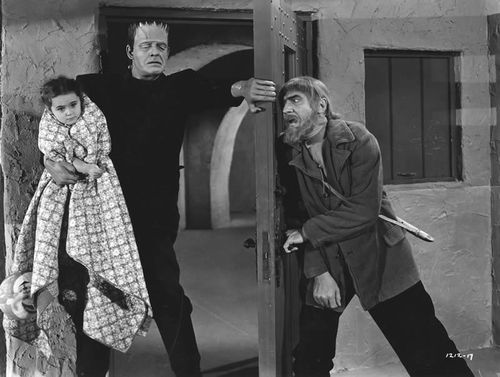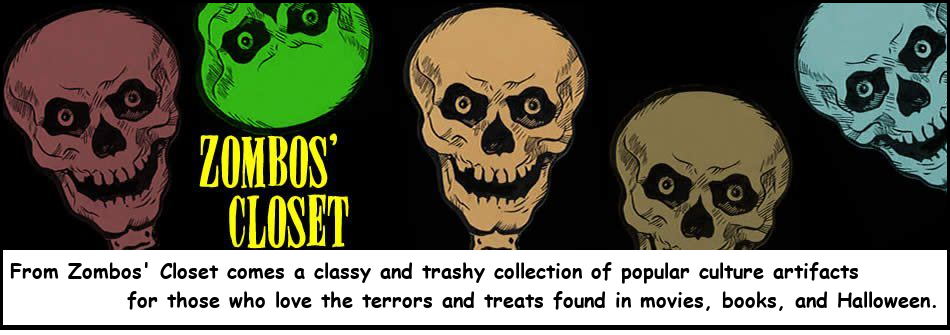
Zombos Says: Very Good
The Ghost of Frankenstein is in many ways the last of the vintage horror movies. Val Lewton, The Uninvited, and Dead of Night were about to bring a new sophistication and literacy to the genre. If the Ghost is already an assembly line job, it’s a good, thoroughly professional, and entertaining one, an honorable close to a solid decade of first rate chillers. (William K. Everson, Classics of the Horror Movie)
Although The Ghost of Frankenstein may be a shade more pale compared to the first three movies in Universal Studios’ Frankenstein series, I disagree with calling it “artless” (Tom Weaver, Michael Brunas and John Brunas, Universal Horrors: The Studio’s Classic Movies 1931-1946, 2ed). Slick, yes; budget assembly line production, yes; but artless? No. Even with Universal’s shift of the series from A to B movie status, Erle C. Kenton’s no-frills direction and Jack Otterson’s art direction still manage to spark a little magic between those electrodes one more time.
Scott Darling, needing more room to meander the Frankenstein Monster’s misadventures further, introduces the second son of Frankenstein, the more sedate Ludwig (Cedric Hardwicke). Ludwig Frankenstein (neither a ‘Baron’ nor a ‘Von’ in his name like his brother in Son of Frankenstein) is a doctor. He’s mastered the science of moving brains in-between craniums. Ludwig practices his brain surgery and psychiatry in the small and happy town of Vasaria. Oddly, Vasaria’s townsfolk do not know anything about his unfortunate family tree, or the problems his deific-prone father and brother have made for that other small and unhappy town within walking distance. But soon those problems will become Vasaria’s when Ygor and the Monster pay a visit after being thrown out of Castle Frankenstein by torch-wielding, grudge-bearing villagers (although they were giddy with happiness at the end of Son of Frankenstein).
The ghost of Dwight Frye puts in an all too brief appearance as one of the despondent villagers. After a Town Hall meeting (note the Americanization) where they pin everything from unhappy babies to bad crops on the ‘Frankenstein Curse,’ the mayor (another Americanization) gives them carte blanche to blow up the castle and pesky Ygor along with it.
Ygor conveniently survived his ‘mortal’ gun wounds received in Son of Frankenstein to continue his chief-instigator role here. He also seems to have scrounged up enough money for much needed dental work and grooming aids. Seeing Lugosi reprise his best role since Dracula and Murder Legendre in White Zombie is more than satisfying, and keeps the action moving briskly. More briskly than Lon Chaney Jr’s portrayal of the Monster—under Kenton’s direction, at least—can muster alone.
Tossing dynamite sticks up at the castle while Ygor drops broken stone battlements from above, the villagers manage to topple one of the castle’s massive towers, revealing—
Look! The sulphur pit’s all dried and hardened since the last movie! And there’s the Monster nestled in it like a bug in a rug! Wait a minute. Wasn’t the pit in the laboratory and both lying adjacent to the castle in Son of Frankenstein? How did the pit and the Monster wind up under one of the castle’s towers for this movie?
—his only friend pickled in the now dried sulfur. Or so surmises Ygor, who is delighted to see the Monster still kicking. He pulls him out of the pit and both make a hasty exit while the villagers blow up the rest of the castle to their heart’s content and much needed venting.
The village mob hysterics may be patent Universal artistry, now economically packaged for filming—I can’t fathom why Universal’s theme parks haven’t picked up on such a great role-playing idea—but Kenton’s artistic flair still comes through and is first seen when a lightning storm erupts and Ygor, trying to persuade the Monster to seek shelter, is pushed aside as Frankenstein’s creation reaches toward the heavens. A bolt of electricity strikes the Monster’s outstretched arms and he welcomes it. Still covered in dried sulfur and surrounded by the desolate nightscape and gnarled trees, he looks like a ghost defiantly rising from his grave.
“The lightning. It is good for you! Your father was Frankenstein, but your mother was the lightning!” says Ygor, who decides to seek out Ludwig, residing in the nearby town of Vasaria, for help.
More becoming to his familiar costume, along the way to Vasaria the Monster loses his Go Go-styled fuzzy vest worn in Son of Frankenstein and dons a dark jacket. When the overly cricked neck Ygor and his overly tall friend walk into town—yes, they simply stroll into town in broad daylight—Ygor stops to chat with a girl to ask directions.
As Ygor talks with the girl, the Monster wanders off when he sees a little girl (Janet Ann Gallow) being bullied by the little boys. He helps her retrieve her ball, which the boys had tossed onto a nearby roof. In the process he manages to panic Vasaria’s townspeople and break enough bones to quickly make Vasaria as unhappy a town as the one he recently left. Low angles with the camera looking up at the towering Monster—showing the little girl’s point of view—increase his menacing presence.
From this movie onward the Frankenstein Monster becomes a scene prop of immense proportions. By the time Glenn Strange takes over the role in House of Frankenstein and Abbott and Costello Meet Frankenstein, the Monster is relegated to being a creepy, big, dummy-like figure; usually strapped to an operating table, around which, indirectly, much of the action occurs. It is this mute, inert body, with arms outstretched in front of him when he does occasionally walk (attributed to Lugosi’s blind Monster performance in Frankenstein Meets the Wolf Man) that gives us the iconic image of Frankenstein’s Monster prevalent in the 1960s up to today.
The plot device of restoring the ailing Monster’s vitality by electrically recharging him, introduced in Son of Frankenstein, now goes one step further here, where it becomes a matter of recharging him before exchanging his abnormal brain with a normal one. Re-energizing and brain-swapping will continue as the main modus operandi for the Monster in Frankenstein Meets the Wolf Man, House of Frankenstein, House of Dracula, and Abbott and Costello Meet Frankenstein, as well as the du jour blueprint for countless future spookshow skits involving mad scientists and Frankenstein Monsters—or plain old gorillas. (For a deliciously goofy example of the gorilla variety see the Three Stooges 3D short, Spooks!)
This shift from Boris Karloff’s misunderstood Monster yearning for acceptance and companionship to Lon Chaney Jr’s mute, lumbering Monster, now weak and semi-conscious, lessens the complexity of the storyline for easier reuse and allows any actor of the right size to mimic the role since it has few emotive requirements, with both conditions important for keeping the budget low and the production simple.
The brain-swapping routine is a hangover from Curt Siodmak’s Black Friday script, facilitating a startlingly gruesome moment when Bohmer wheels a bottled brain directly into the camera lens. (Jonathan Rigby, American Gothic: Sixty Years of Horror Cinema)
There is also a more important thematic shift in the Monster’s relationship with his world. This theme, begun in Son of Frankenstein and developed further here, either accidentally or subconsciously, as a result of Universal moving the series to B production status, contains layers of meaning not usually discussed when The Ghost of Frankenstein and House of Frankenstein are mentioned.
And what is this theme, pray tell?
I've been thinking about what I'd like to see happen in this brand new year. A few hopes really, not much, but enough to look forward to.
